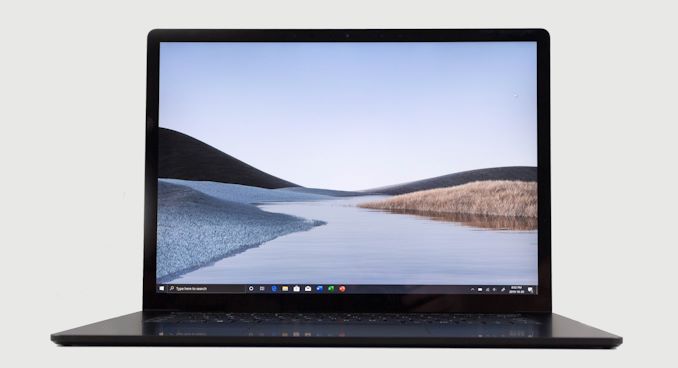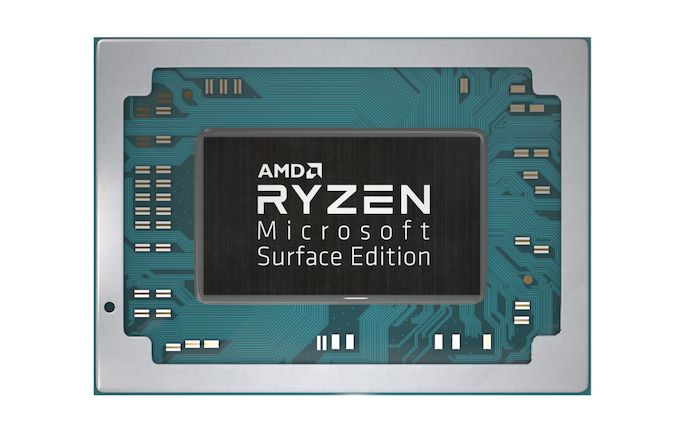The Microsoft Surface Laptop 3 Showdown: AMD's Ryzen Picasso vs. Intel's Ice Lake
by Brett Howse & Andrei Frumusanu on December 13, 2019 8:30 AM ESTFinal Words
Two laptops. Two platforms. It is rare to have a chance to see a manufacturer offer such equal footing to both AMD and Intel by outfitting a premium laptop with processors from both. It represents a rare opportunity to get to test the latest processors from AMD and Intel in a laptop in such an apples-to-apples fashion.
In the laptop space, design, cooling, and a manufacturers requirements can play a big part in how a particular chip performs, thanks to adjustable power level settings, surface temperature adjustments, and more. We have seen the lowest tier CPU outperform the highest tier CPU just by the virtue of a better cooling system, so to have processors from AMD and Intel, both of which launched in 2019, in the same chassis is a wonderful opportunity.
There aren’t too many ways to sugar coat the results of this showdown though. AMD’s Picasso platform, featuring its Zen+ cores and coupled with a Vega iGPU, has been a tremendous improvement for AMD. But Intel’s Ice Lake platform runs circles around it. Sunny Cove cores coupled with the larger Gen 11 graphics have proven to be too much to handle.
On the CPU side, no one should be too surprised by the results. We've already seen on the desktop that AMD’s Zen+ cores were competitive, but slightly slower than the previous Skylake platform; and the new Sunny Cove microarchitecture from Intel is a big step forward in terms of IPC for Intel. On purely CPU based tasks, Ice Lake really stretched its legs, and despite this being a 3.9 GHz chip, in single-threaded SPEC 2017, it managed to come very close to a 5.0 GHz Core i9-9900K with a massively higher TDP. Zen+ is outclassed here, and that showed in the benchmark results, and especially in the benchmark time. On our 8-thread SPEC 2017 run, the Ice Lake platform finished just a hair over two hours ahead of Picasso.
But things fare better for AMD on the GPU side of matters. Even though Intel has certainly closed the gap with Ice Lake's iGPU, AMD seems to continue to hold an advantage, especially on the 11 Compute Unit Ryzen Surface Edition processor found in the Surface Laptop 3. Intel has dedicated a lot more die area to the GPU and the results put them almost on equal footing with the Vega based GPU on Picasso. On the more complex GPU tasks, AMD tends to have a slight lead, and AMD’s low-level driver support also seems to benefit them on DirectX 12 based tasks. But, Ice Lake’s GPU is helped by the much quicker CPU it is coupled to, so depending on the specific test it can be even quicker.
Ice Lake does all of this with much better power efficiency as well. Overall battery life is quite a bit longer, and idle power draw is notably lower as well. Case in point: at minimum screen brightness, the Ice Lake system was pretty much only sipping power, drawing around 1.7 Watts, versus the 3.0 Watts for the AMD system.
It was fantastic to see AMD get a design win in a premium laptop this year, and the Surface Laptop 3 is going to turn a lot of heads over the next year. AMD has long needed a top-tier partner to really help its mobile efforts shine, and they now have that strong partner in Microsoft, with the two of them in a great place to make things even better for future designs. Overall AMD has made tremendous gains in their laptop chips with the Ryzen launch, but the company has been focusing more on the desktop and server space, especially with the Zen 2 launch earlier this year. For AMD, the move to Zen 2 in the laptop space can’t come soon enough, and will hopefully bring much closer power parity to Intel’s offerings as well.
Meanwhile for Intel, Ice Lake has been years in the making, and, after a long delay, it is finally here. After digging into the platform in-depth, it’s clear that Ice Lake is an incredibly strong offering from Intel. The CPU performance gains are significant, particularly because they were made in the face of a CPU frequency deficit. But the biggest gains were on the GPU side, where Intel’s Gen 11 GT2 in its full 64 Execution Unit configuration is likely the biggest single increase in GPU performance since they started integrating GPUs. It pulls very close to AMD’s Vega, closing the gap in performance to almost zero.
2019 has been a big year in the laptop space, with both Intel and AMD bringing new tools to the game. 2020 should be just as exciting, and if we’re lucky, we’ll get another chance to do this all over again.













174 Comments
View All Comments
Fataliity - Saturday, December 14, 2019 - link
That came out wrong re-reading it. sorry its late. AMD's die is twice the size which should let it cool better. and apu ccx is 60mm squared, intel's for 4 cores is almost the same on ice lake. So yes a similar power for similar heat would make sense. We don't know what's coolin the inside on both of these either though, that could make a big difference. However, I still think it's questionable when Intel boosts and hits 100 degrees C, just looks like they're pushing the CPU as far as possible to make it look as good as it can, knowing the new APU's are coming out soon.And yes, the fact that it can draw 42 watts on CPU at boost definitely seems like an unfair advantage. The temps also reflect that in 25 seconds it overheats due to it too, forcing to ramp down.
Fataliity - Saturday, December 14, 2019 - link
And I looked into the IO. It should pull 10-15W, including graphics idle, putting Ryzen on par with Ice Lake around 20-25 watts. Which would make more sense.pifaa - Saturday, December 14, 2019 - link
Personal opinion. The review is very obviously biased towards Intel. The tests are carefully sellected to demonstrate Intel dominance, which in the real world is non present anymore. The only advantage Intel still has over AMD in the mobile space, is power consumption. As we see, that advantage is shrinking fast.m53 - Saturday, December 14, 2019 - link
Personal opinion. The earth is flat.GruenSein - Saturday, December 14, 2019 - link
The results are no surprise. It’s Intel‘s newest architecture and manufacturing node against AMD‘s year old Zen1+ on 12nm. It’s too bad that AMD take their time updating mobile parts and APUs. A Zen2 + Navi on 7nm should be much more competitive. This is the inverse situation we see in desktop parts where there is no sunny cove and still 14nm for Intelyeeeeman - Saturday, December 14, 2019 - link
Lets see what AMD brings to the table with zen 2. Intel does have a better ipc with ice lake, even compared to zen 2, but it has a handicap in the fact that it is built on 10nm and they have only 4 cores in 15w tdp. I am pretty confident that AMD can afford a 6 core in the same tdp, like comet lake.dragosmp - Saturday, December 14, 2019 - link
The boost behavior is very erratic on the AMD. I assume this ramping up/down under load is quite inefficient and buts a high emphasis on how fast the CPU can ramp up and down.Looks very erratic to the point of being defective. Multi-core loads though are fine. Does this mean when a low-threaded task is ran the scheduler bunny hops the task on all cores? This used to be a problem on Ryzen1 and thought it was solved with an AMD driver, but it came back maybe on this MS product.
I suspect a few % performance were left on the table, but like most here I assume the GPU is bandwidth-starved and high speed memory can't come soon enough for AMD. Quite surprising how poor they are with feeding the GPU, lack of dev on the GPU side in the last few years has hurt a lot.
AshlayW - Saturday, December 14, 2019 - link
Awesome result for the Ice Lake chip. But let's keep expectations in check here; the Ryzen part is based on a uArch from 2017 with slight optimisations, and also has half the L3 cache size due to a significant process disadvantage. While a very valid product v product comparison it is not particularly 'fair' as Intel's development (sunk) costs for the ICL and 10nm node are astronomically higher than Picasso's.I consider this 'flavour' until AMD can finally pull its finger out of its rear and get Zen2 mobile cores on 7nm, which should match or beat this. Finally, the memory limitation on the Picasso part is severely holding it back. I have no idea they wouldn't have opted for DDR4-2933 (what Picasso supports natively), which can lower its clock rate in less demanding tasks for higher efficiency. In some of these tests, this could have allowed AMD the win (which would have been particularly impressive given the huge aforementioned uArch/Node advantages Intel has). The bandwidth would have especially helped in the graphics tests. If the AMD surface design is significantly cheaper (I am willing to bet AMD can give these chips for 25% of what Intel is selling the ICL for) it could slot nicely in as a lower performing, but also much lower cost alternative.
I will wait patiently for Renoir to see what 7nm Zen2 can do in mobile; arguablly where it is most needed.
scineram - Monday, December 16, 2019 - link
I think they worried about power with faster memory.MBarton - Monday, December 30, 2019 - link
profit margin limited and not enough leftover Zen 2 after satisfying Epyc orders, THR3/Ryzen 3k, and console orders.